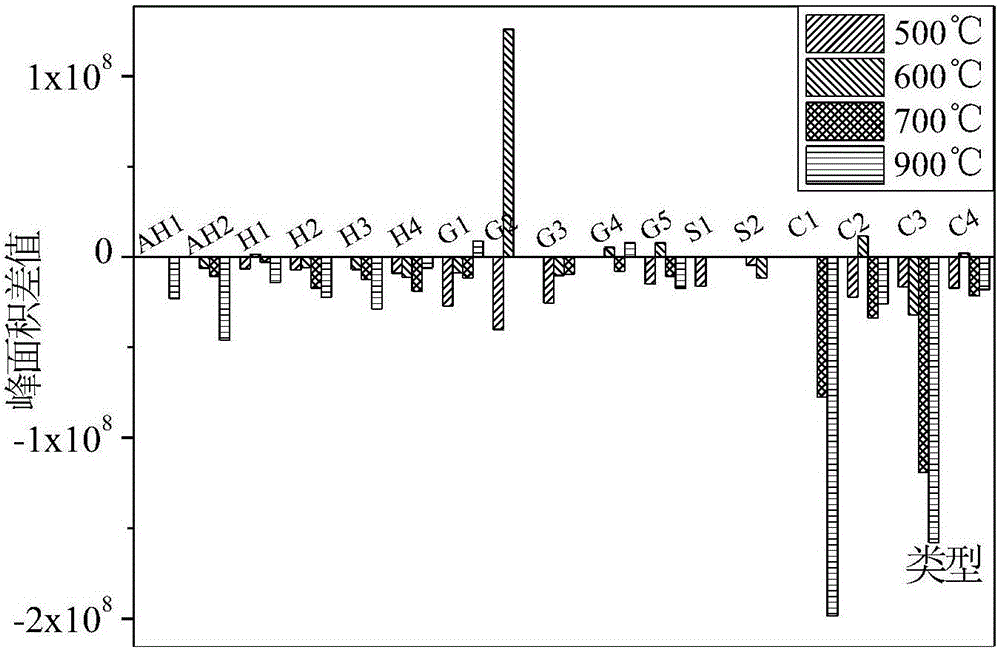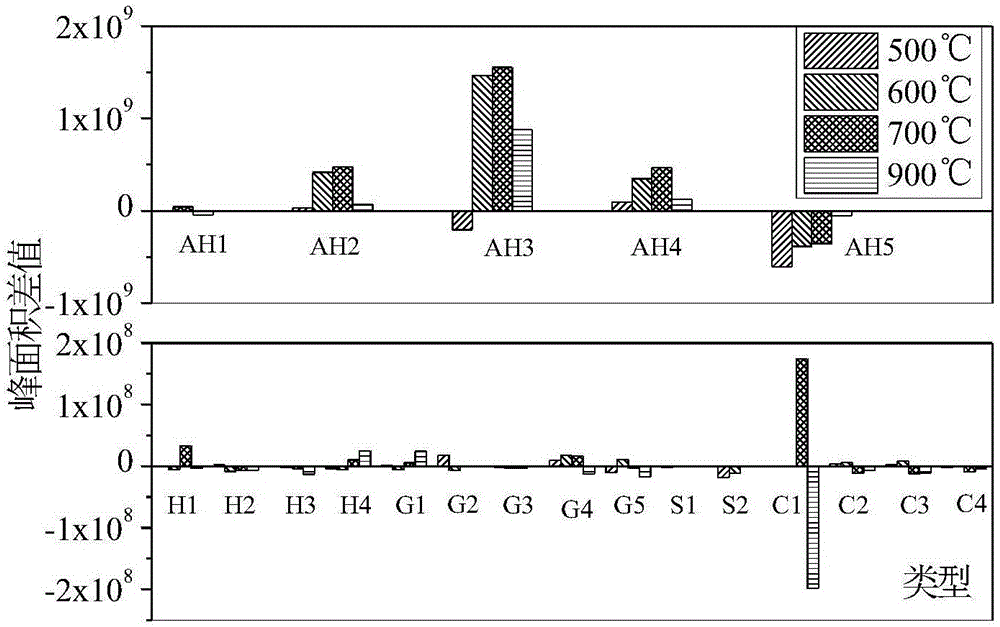Method for preparing aromatic hydrocarbon compound through blending pyrolysis of lignin and low-density polyethylene or polycarbonate or polystyrene
A low-density polyethylene and polystyrene technology, which is applied in the preparation of hydrocarbons, hydrocarbons, and organic compounds, can solve the problems of difficult conversion and degradation, and achieve the goal of reducing the amount of residual carbon, promoting the generation, and cleaning the process Effect
- Summary
- Abstract
- Description
- Claims
- Application Information
AI Technical Summary
Problems solved by technology
Method used
Image
Examples
Embodiment 1
[0018] Reaction conditions: Weigh 1mg of black liquor lignin, low-density polyethylene, polycarbonate and polystyrene as a separate pyrolysis sample, and weigh 0.5mg of lignin and 0.5mg of low-density polyethylene (polycarbonate or polystyrene) Styrene), 0.5 mg of lignin was mixed with 0.5 mg of the above three polymers as a blend. Put 7 kinds of samples into quartz tubes respectively, fix both ends with quartz wool, and put them into a hot wire type fast pyrolyzer for fast pyrolysis reaction. The fast pyrolyzer is connected with gas chromatography mass spectrometry (GCMS), and the volatiles generated by pyrolysis can be detected by GCMS. The reactant is set in the fast pyrolyzer at a temperature of 500-900°C, and the heating rate is 20°C / ms to carry out the pyrolysis reaction. According to GCMS analysis, lignin and the above-mentioned polymers are blended and pyrolyzed, and the composition of the pyrolysis oil has changed to a certain extent.
[0019] Figure 1-3 The compa...
Embodiment 2
[0024] Based on the results of Example 1: rapid pyrolysis of lignin and polystyrene can effectively promote the formation of monomeric aromatic hydrocarbons, so lignin and polystyrene were selected as raw materials for the study of Example 2.
[0025] A certain amount of lignin and polystyrene were weighed and mixed, and the mass ratio of lignin to polystyrene in the mixture was about 1:4 and 4:1. Put the blends into quartz tubes respectively, fix both ends with quartz wool, and put them into a hot wire type fast pyrolyzer. The pyrolysis reaction is carried out at 20°C / ms. The fast pyrolyzer is connected with gas chromatography mass spectrometry (GCMS), and the volatiles generated by pyrolysis can be detected by GCMS. In order to analyze the effect of the blending ratio of lignin and polystyrene on the main aromatic hydrocarbons in the pyrolysis products.
[0026] Figure 4 The theoretical and experimental value comparison of the peak area of aromatic hydrocarbons in the ...
Embodiment 3
[0028] Weigh 10mg of lignin and polystyrene as a separate pyrolyzed sample, and weigh 5mg of lignin and 5mg of polystyrene, mix them uniformly to obtain a blend, and pass the three samples through a thermogravimetric infrared spectrometer ( TG-FTIR) for detection of weightlessness and gas evolution. The heating range of TG-FTIR is 25-900°C, and the heating rate is set at 20°C / min. The pyrolysis weight loss and weight loss rate curves of lignin and polystyrene blends are as follows: Figure 5 As shown, the escape of small molecules during the blending and pyrolysis of the two is as follows Image 6 shown. from Figure 5 It can be seen that there is a certain interaction between lignin and polystyrene mixed pyrolysis. Table 2 shows the values of the characteristic points of the TG and DTG curves of the three samples. There is no significant difference between the theoretical and actual weight loss range and the maximum weight loss rate of blend pyrolysis, but from the wei...
PUM
 Login to View More
Login to View More Abstract
Description
Claims
Application Information
 Login to View More
Login to View More - R&D
- Intellectual Property
- Life Sciences
- Materials
- Tech Scout
- Unparalleled Data Quality
- Higher Quality Content
- 60% Fewer Hallucinations
Browse by: Latest US Patents, China's latest patents, Technical Efficacy Thesaurus, Application Domain, Technology Topic, Popular Technical Reports.
© 2025 PatSnap. All rights reserved.Legal|Privacy policy|Modern Slavery Act Transparency Statement|Sitemap|About US| Contact US: help@patsnap.com



